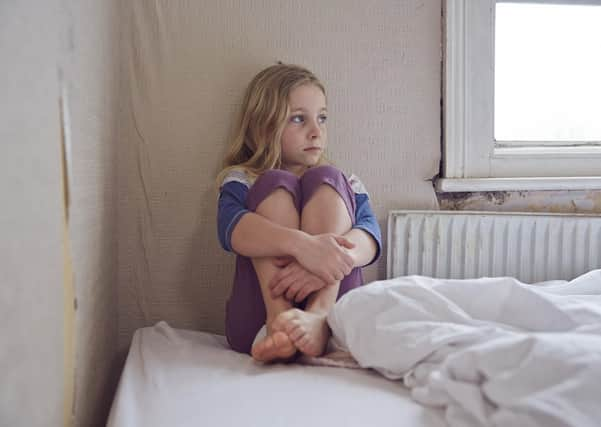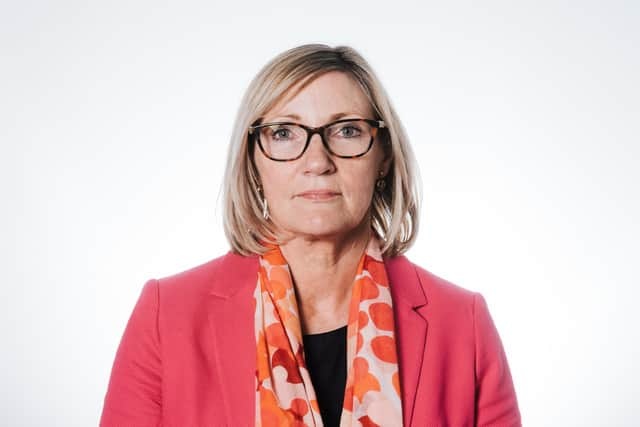“I believe we’ve changed the course of their lives” - Caring for children when no-one else can


A child being separated from their family is probably the most distressing thing they could experience in their young lives.
And removing a child from their family home is not a decision Calderdale Council ever takes lightly.
Advertisement
Hide AdAdvertisement
Hide AdBut not all family homes are places of love and warmth. Some can be full of fear and pain.


“We get a lot of cries for help from parents - ‘I can’t cope anymore, come and take them into care’, says Julie Jenkins, director of children and young people’s services for Calderdale Council.
“We don’t want to do that, we try everything we can to support them immediately, start working with the parents and the young person.
“When they come into care you’re unpicking years and years of what’s happened before.
Advertisement
Hide AdAdvertisement
Hide Ad“We get a lot of referrals from people who are worried about a child, and we have a big team who deals with that.”It might be about a child who is home alone, mum is nowhere to be seen or at the pub.


“We have an initial look and do an assessment with the police and schools.
“If we think there’s a risk, maybe mum has a drink problem, we’ll start a child protection plan. If mum keeps drinking, keeps going missing and leaving the child at home, they may come into care.
“So it goes through a process.
“We have a social work team operating 24/7 every single day and we work closely with the police.
Advertisement
Hide AdAdvertisement
Hide Ad“It’s rare we deal with emergencies where there is no-one to look after a child, but we would then step in and take them into care.
“Generally though, we are dealing with children who have been abused and we believe it is not safe for them to stay at home after we have done an assessment.
“It’s generally kids who have been hit, there might be a lot of domestic violence going on in the house. We call it a toxic trio, if you’ve got mental health issues, you’re using substances and you’ve got domestic violence, that’s a lot going on.”
There are 340 children are currently in the care of the council, who receive around 800 referrals every month.
Advertisement
Hide AdAdvertisement
Hide AdThe council also regularly visits children who are home-schooled, and support children after they leave care up to the age of 25.
“We’ve put a lot of extra resources into the ‘front door’ as we call it, where referrals come in,” says Coun Adam Wilkinson (Lab, Sowerby Bridge), cabinet member for children and young people’s services.
“We’ve been on an improvement journey since 2013 when we were rated inadequate.
“But at our most recent inspection, in 2018, we were rated good with outstanding features, which is something we’re really proud of.
Advertisement
Hide AdAdvertisement
Hide Ad“We were told we needed to take a closer look at the ‘front door’, so we’ve reviewed the processes, put in extra resources and strengthened that team for when referrals first come in.
“We had a health check done by staff from two other Yorkshire boroughs to see how they think we’re doing, and the result was really pleasing.
“So we’re definitely on the right track there. The message we try to get across is that safeguarding is everybody’s business, whether you’re a teacher, doctor or member of the public.
“We train as many people as we can to look out for the signs.”
Advertisement
Hide AdAdvertisement
Hide AdThe council runs a short-break unit for children with disabilities, a small unit for younger children, a longer-term unit for teenagers and an outreach support unit which is being converted into another longer-term unit.
“We do a lot of pre-entry checks, background assessments and placement matching,” says Guy Greenwood, senior homes manager for the residential service.
“It’s about how we can marry a care package together with that child so we don’t disrupt current service users but integrate someone else into a family network.
“We might go to a foster family or a residential home and do a meet and greet, chaperone them with their social worker.
Advertisement
Hide AdAdvertisement
Hide Ad“Then we’d plan their transition, maybe with them going for tea, reflect and discuss, look at what their anxieties are.
“We’d maybe go for tea again but more communally so they’re socialising with other young people.
“Then we’d work towards a moving date. It’s done with a lot of sensitivity because for a young person to move home, it’s probably the biggest change in their life.
“But if it’s done in a planned way, they’re pretty successful.
Advertisement
Hide AdAdvertisement
Hide Ad“There is a lot of settlement work early on but we have a ‘one team, one parent’ approach, because it creates consistency for that young person.
“They will have setbacks, but we’re not missionaries there to rescue them. We’re more anthropologists, we’re more curious, exploring what’s going on.
“You can be faced with externalised behaviour, a lot of abuse, but you’re trying to unpick what’s behind that, which is something the service has got so much better at.
“The infrastructure around young people is second to none. I’m one phone call away from getting support and guidance, and there’s a plethora of services that lend themselves to our success.
Advertisement
Hide AdAdvertisement
Hide Ad“We have stabilised young people into long-term placements, and I believe we’ve changed the course of their lives.
“They’ve come to us with graphic histories, and no real plan b, but we’ve put layers of support in place.
“I think services in the private sector are following our lead, which is a nice testament to us.”
Mr Greenwood has had two children return to their families within the last couple of years at the residential home he runs.
Advertisement
Hide AdAdvertisement
Hide Ad“That was never on the table when they came into care because the risk was far too great.
“But with the support of other services - health, social care, education - we’ve been able to convert the thinking of the parents and the way they look after their children.
“They’ve maybe been failed as children themselves, but we’ve been able to break that cycle.
“To get two like that inside two years is nothing short of a miracle in this line of work.”
Advertisement
Hide AdAdvertisement
Hide AdClaire Brodie, service manager for looked after children in Calderdale, chairs a placement resource group on a Tuesday morning which oversees every placement in the borough.
“The thinking and the planning starts very early on so we get the right young person into the right home to give them the best care,” she says.
“We have good relationships with outside agencies so they know who to come to, they know people and they know the processes.
“We have eight children living in our two residential homes, and if we can’t provide that residential care, or it’s safer for that person, we look to go outside the borough.”
Advertisement
Hide AdAdvertisement
Hide AdOf the children in Calderdale placed with Independent Foster Agency carers, just over half of those are outside the borough.
There are 11 children in external residential care outside the borough, and 15 in Calderdale.
“Ninety per cent of all local authorities are overspending on their children’s social care budgets,” says Coun Wilkinson.
“We tend to overspend each year, and it’s the external placements that are particularly costly.
Advertisement
Hide AdAdvertisement
Hide Ad“We are trying to reduce those placements, by creating more in-house placements.
“We’ve put a lot of money and resources into fostering as well, but the funding is a national issue, so whatever we try to do, I fear it’s just never going to be enough until there’s a new national approach.”
”We can run our own residential care at a pretty cost-effective manner, but the cost of outside provision has shot up,” says Ms Jenkins.
“If we can’t find a foster family, we have to use residential care, and if we can’t provide that, we have to buy it in. And that costs a lot of money.
Advertisement
Hide AdAdvertisement
Hide Ad“But we are creating more provision in Calderdale. We’ve got support to look at increasing more of our own residential care so we don’t have to buy it in.
“We are good at keeping kids here. We’re all about giving them the best care we can and keeping them in the borough so they can grow up here and become brilliant citizens for Calderdale.
“It’s going to be a test to manage our budget so that we don’t cause pressure on other services. Some of the work we do to keep kids out of care will be important for that.”
”When you’re entrenched in it as a family,” says Mr Greenwood, “you can’t see the wood for the trees, so we coach parents to think about what’s happening.
Advertisement
Hide AdAdvertisement
Hide Ad“It’s about working with people and talking with them, not at them.
“You become a counsellor, a confidante, a shoulder to cry on. That’s important to parents because a lot of parents we see are lost.
“We’ll probably never be able to measure the success of how many young people we’ve stopped coming into care.
“With some families, you’d never think six months previously the house you’re dealing with would end up where it’s at six months down the line.
Advertisement
Hide AdAdvertisement
Hide Ad“It does work, but it’s about repetition, consistency, and never giving up, no matter how many times you go to that house and get turned away.
“It’s about ‘what would you do for your own kids’. It’s humbling that our staff think like that.
“The attitude and aspiration among our teams is shifting. For me, I’d like us to be the flagship, the place that people follow.
“I don’t think that’s unrealistic because the belief is there among our staff.”
Advertisement
Hide AdAdvertisement
Hide AdThe council has plans to increase their care provision into Brighouse and Todmorden so that each end of Calderdale is catered for, and wants their children and young people’s service to become outstanding. It is currently rated good by Ofsted.
“When you see the feedback during a closing summary on where a family was at the start and where they are by the end, it’s heartwarming and makes you damn proud to be part of Calderdale’s service area,” says Ms Brodie.
“We want to reduce the number of children we look after, and to develop our services in line with listening to the child’s voice.
“We’ve got some outstanding provision, and we want to grow more of it, so we’re doing our best for children that need care.”
Advertisement
Hide AdAdvertisement
Hide Ad”It’s about changing the stigma that’s attached with residential care,” adds Mr Greenwood.
“Calderdale’s got the opportunity to change that association of why young people are in care, and it’s not the truth.
“We can sustain long placements where they do feel they’re part of a family.
“Our home is a home, which offers young people security.
“There’s inspirational artwork, a nice kitchen and bedrooms.
Advertisement
Hide AdAdvertisement
Hide Ad“And we pride ourselves on our Christmas tree - it’s like something you’d see in Selfridge’s!
“Christmas is a difficult time for them because it’s centered around family, but a lot of youngsters don’t get the opportunity to celebrate it with their families.
“We’ve been open since June 2016 and we really gear up for Christmas.
“Our young people feel they are loved and cared for, which is all we ask for.
“I ask a lot of staff, but I ask for the same care they would give their own kids, and they do that.
“There’s no lengths they don’t go to, which is humbling.”